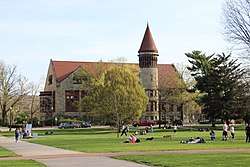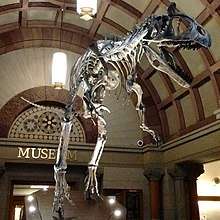University, Hayes and Orton Halls
University, Hayes and Orton Halls are three historic buildings on the Oval at the Ohio State University in Columbus, Ohio. On July 16, 1970, they were added to the National Register of Historic Places under No. 70000492.
University, Hayes and Orton Halls | |
 Orton Hall | |

Interactive map of the buildings | |
| Location | Columbus, Ohio |
|---|---|
| Coordinates | 40°0′4.78″N 83°0′52.43″W |
| Built | 1893 |
| Architect | Yost & Packard |
| Architectural style | Romanesque |
| NRHP reference No. | 70000492[1] |
| Added to NRHP | July 16, 1970 |
University Hall
The original University Hall was constructed in 1873, and contained a majority of the university functions, including both student and faculty housing. After being closed in 1968 for safety reasons, the building was completely torn down in 1971. At this time the old hall was removed from the National Register of Historic Places.[2] The current University Hall was reconstructed in its place, taking an almost exact outward copy of the original building, but updating the inner workings. It was completed in 1976.[3]
Hayes Hall
The building is named after President Rutherford B. Hayes, who was also the governor of Ohio and advocated for a newly established land-grant university in Ohio. The construction date for Hayes Hall is 1893, making it the oldest remaining building on the Ohio State University campus.[4] Built as a wood frame structure with a brick exterior that includes a distinctive carved stone archway at the center of its front façade, the original building included a basement and three stories of spaces to be occupied by students in Industrial Arts program, the Art Department and the Military Department who shared the building. Its original cost was approximately $55,000.
The main level of the building originally contained the public office for the Military Department and an extensive gun room that filled the rear wings of the building. Classrooms also occupied the spaces on either side of the main building. On the second floor, offices for the Art Department and the Rural Economics Office could be found, along with Art and Design classrooms and an indoor target range for the Military Department, found in the wing at the rear. Art classrooms and a large Engineering Drawing lab occupied the upper level and extra gun rooms and an officers’ room were located in the basement at the time of the building's opening.
Hayes Hall got its name from Rutherford B. Hayes, President of the United States and three-time governor of Ohio, on November 17, 1891. President Hayes also served as a member of the OSU Board of Trustees. The association between President Hayes and land-grant education has to do with the fact that he served as the governor of Ohio at the time that the state accepted the federal Morrill Act, which established land-grant colleges including OSU across the country. The fact that Hayes strongly advocated for providing the students of Ohio with mechanical education further connected him to Hayes Hall since the building housed the initial Industrial Arts program on campus. The lower floor originally contained a foundry for the use of Industrial Arts students. Although Hayes knew of the naming of the building prior to his death in January, 1893, he never saw it completed. Hayes Hall was first occupied on February 1, 1893 after heat was finally supplied to the building.
Over the years, the uses of Hayes Hall have changed. From its initial occupation by the Industrial Arts, Art and Military Departments through the twentieth century to today, as the home of the Department of Design, Art's drawing studios and OSU general classrooms, many alterations have been made to the structure. A small portion of the northeast side of the building was demolished around 1936, and more extensive demolition of the wings that once housed the gun rooms in that same area occurred in the 1940s. A lean-to on the northwest side at the rear was also removed at that time. More modifications to the rear occurred in the 1970s when a new stair tower was added toward the back to enhance the building's safety and efficiency and the lobby was dramatically altered by the removal of a pair of stairs that led to the building's upper floors. Faculty offices were constructed in the two side wings of the main floor at that time. The building housed the History of Art Department throughout much of the latter part of the twentieth century and many alumni remember having classes in the reconfigured spaces on the upper two levels of the building at that time. While some of these changes have been furthered in two additional waves of renovation, much of the building is as it was laid out in the 1970s.
Despite the many changes that have occurred to Hayes Hall over its history, the building was placed on the National Register of Historic Places on July 16, 1970 due to the fact that its front façade remains virtually untouched from its original appearance. Recent efforts to restore some of the eroding stonework on the arch and the stone steps leading to the building work toward maintaining Hayes Hall's historic architectural integrity.[5]
Orton Hall

Orton Hall, one of the oldest remaining buildings on Ohio State University campus, opened in 1893 and is named after Dr Edward Orton, Sr. who served as OSU's first president, Professor of Geology from 1873 to 1899, and Ohio's State Geologist from 1882 until his death in 1899. Orton Hall is a tribute to this man's dedicated service towards the understanding of the geology of Ohio.
Orton suffered a partially paralyzing stroke in 1891, but continued to work. Ohio State University constructed a geological pleasure dome in 1893, and named it Orton Hall, in tribute to Edward Orton's seminal contributions.
The Hall is built of forty different Ohio building stones. In the outside walls, these stones are laid in stratigraphic order according to their relative positions in Ohio's bedrock. The capitals of the numbered columns in the entrance hall feature carvings of fossils, such as trilobites, as well as other objects such as the races of Man. The bell tower was dedicated in 1915 and contains 25,000 pounds of bells that can be heard regularly tolling across campus in the key of E-flat. Encircling the top of the tower are 24 columns with gargoyle-like figures which are restorations of fossil animals.
Because of its unique architectural features, which have made it a campus landmark, Orton Hall has been entered into the National Register of Historic Places. It presently contains the School of Earth Science's offices and laboratories of Paleontology, Historical Geology and Sedimentology, the Orton Geological Museum, and the Orton Geological Library.
Orton Hall features a bell tower with 12 chimes that toll every 15 minutes to the tune of the Westminister Chimes. An instrumental depiction of the chimes features in an often heard arrangement of the school's alma mater, Carmen Ohio.[6]
In 2018, a 24-foot-long (7.3 m) replica of a Cryolophosaurus ellioti dinosaur was installed in the Orton Hall lobby. The replica was cast from a skeleton found in Antarctica by Ohio State University geologist David Elliot in 1991. The skeleton has been described as the most complete skeleton ever found on Antarctica. Cryolophosaurus ellioti was a predator that lived 190 million years ago during the Early Jurassic. A crowdfunding campaign raised $80,000 in order to pay for the replica and its installation.[7][8][9]
References
- "National Register Information System". National Register of Historic Places. National Park Service. January 23, 2007.
- 36 FR 23258
- "Original University Hall razed, 40 years ago today | From Woody's Couch". library.osu.edu. Retrieved 18 April 2018.
- "Hayes Hall". Buckeye Stroll. The Ohio State University. Retrieved 19 September 2016.
- "History of Hayes Hall". Department of Design. The Ohio State University. Retrieved 19 September 2016.
- "Twelve Days of Buckeyes: Orton Hall's 12 chimes have rung for nearly a century". From Woody's Couch. The Ohio State University Libraries. 6 December 2012. Retrieved 24 May 2014.
- Raudins, Sam (September 19, 2018). "Jurassic campus: Dinosaur arrives at Orton Hall". The Lantern. Retrieved November 29, 2018.
- Stankiewicz, Kevin (September 21, 2018). "Beware of dinosaur: Skeleton replica on the prowl in Ohio State's Orton Hall". Columbus Dispatch. Retrieved November 29, 2018.
- Wiley, Chelsea (September 24, 2018). "The New Dino At OSU's Orton Geological Museum Is Freakin' Awesome". Columbus Navigator. Retrieved November 29, 2018.
External links
| Wikimedia Commons has media related to University Hall (Ohio State). |
| Wikimedia Commons has media related to Hayes Hall (Ohio State University). |
| Wikimedia Commons has media related to Orton Hall. |